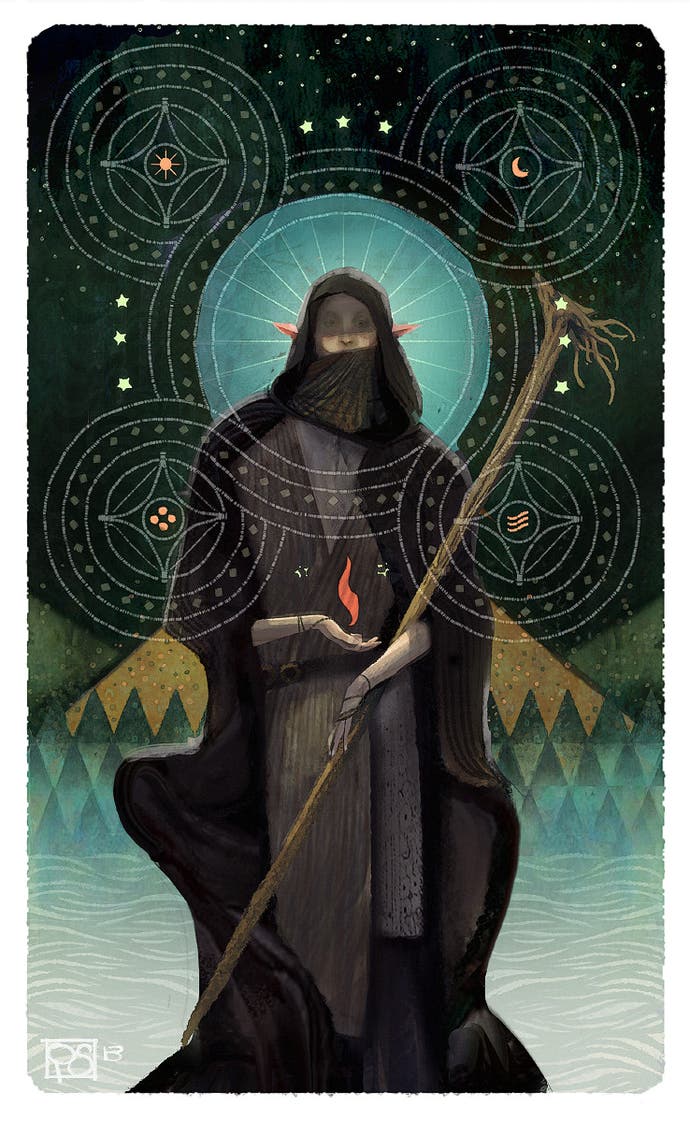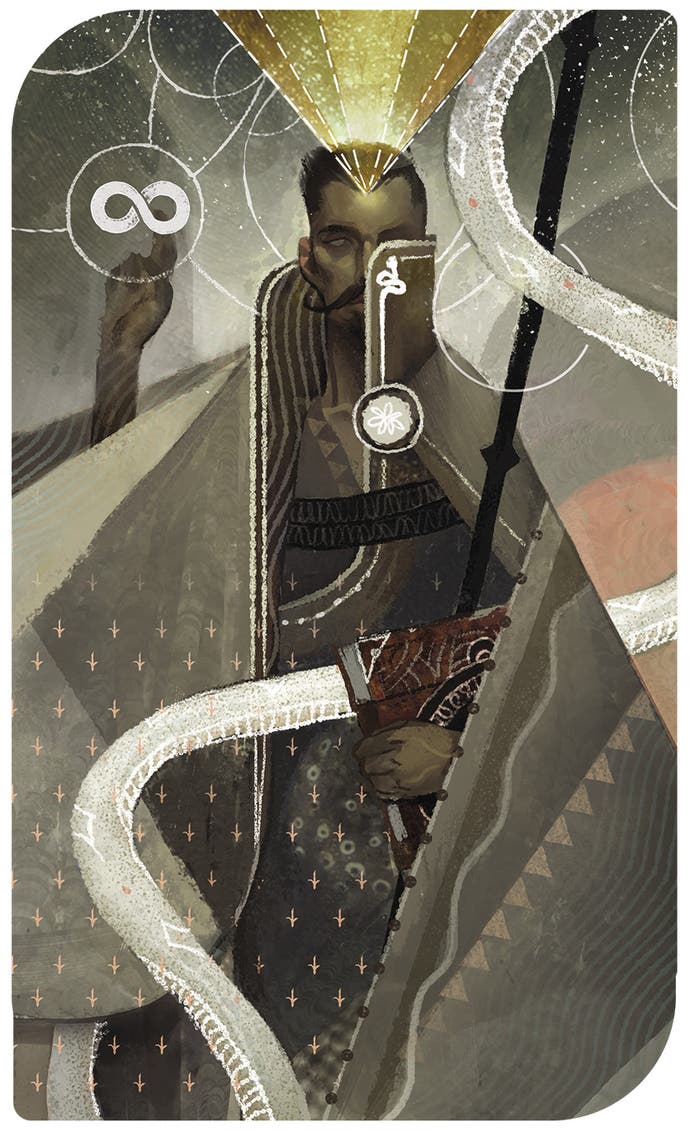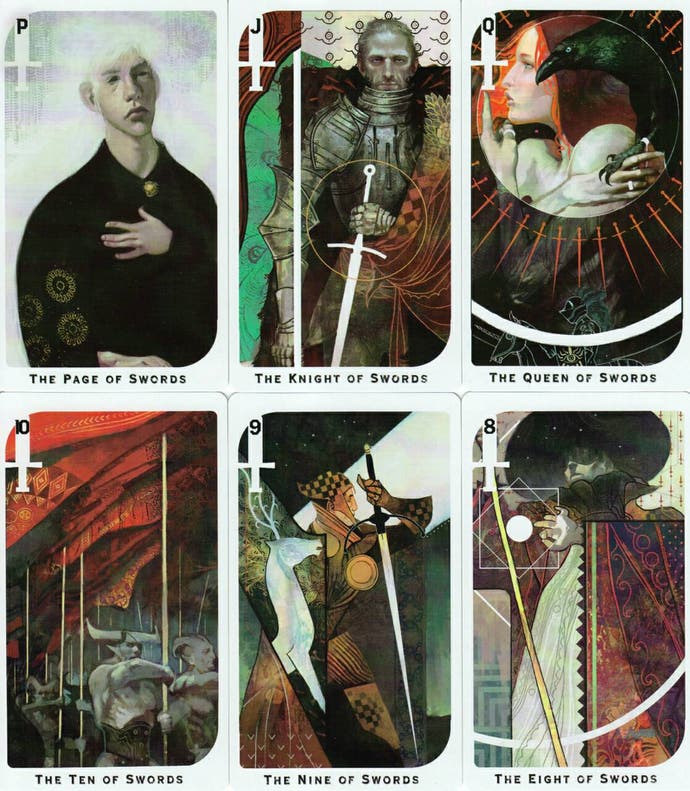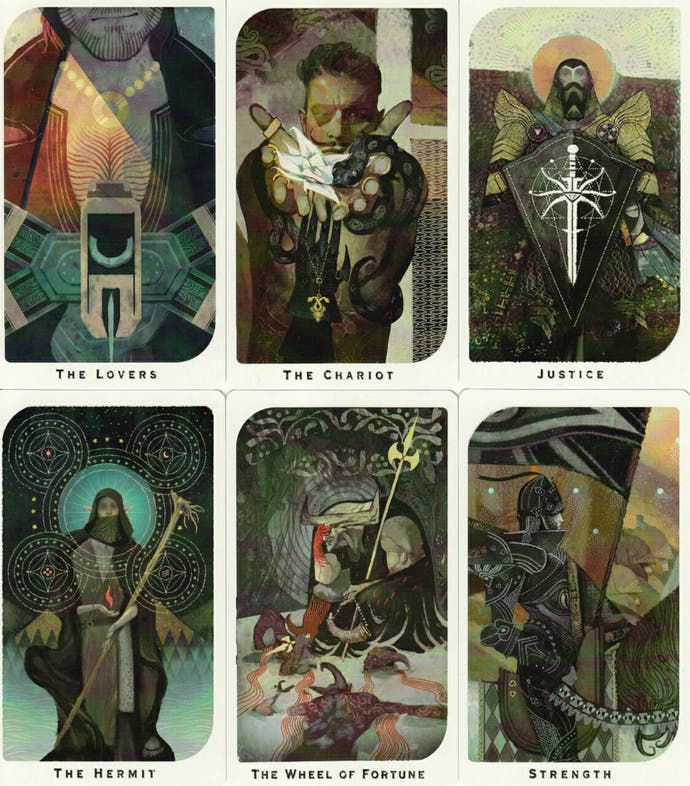Through the Dragon Age: Inquisition tarot cards I found art
Keeping me warm in Tevinter.
I adore the tarot cards in Dragon Age: Inquisition. Whoever came up with the idea, I could kiss you. I could happily look at the cards all day - and I have, sorry colleagues. I have bought them to frame and hang on my wall, and I've never done anything like that before. It's odd - Dragon Age isn't known for its art. Origins was ugly and Dragon Age 2 was all over the place, caught between old and new. They had art, but it wasn't important. But with Inquisition it changed.
Inquisition had tarot cards. They lived in the menus, representing all facets of the game. They were the characters you met, changing along with your relationships, and they were the class you chose, monsters you killed, achievements you earned. And they were there the moment you started your game, in your face, dazzling in their deliciousness.
OK, so technically they're not all tarot cards. Some are simply gorgeous pictures shaped like cards. But there are enough actual tarot to fill a 78-card deck, which EA printed for the £140/$160 Collector's Edition of the game. I wish I'd bought it - you can't find it for less than hundreds of pounds on eBay these days, the deck. Sure, you can buy them as playing cards (and I have) but it defeats the point.
Because their being tarot cards is the whole reason I love them. Tarot means unconventional and weird to me, which isn't like BioWare at all, normally so bland and clinical. And tarot are covered in symbolism I don't understand, as if a whole other story lurks there waiting to be discovered. It fascinates me!
It really calls to me because I've seen this kind of thing before, back in history lessons. We were learning about Renaissance paintings and religious paintings, and the teacher was telling us - and I was almost listening - about how everything within the frame had meaning. Hand gestures, items, colours, even fruit. And there I was just thinking the babies looked weird. But it stuck with me. And it all flared up again when Inquisition came along.



Look at those pictures - cool, aren't they? And they're not the half of it, believe me. You can't look at those and not see hidden meaning. Look how deliberate the hand gestures are and what they're holding. Fingers pointing upwards, infinity symbols, open palms with flames in, weird circles and stars and radiating light.
But what really catches my eye is the orange behind the head of the guy on the left (Blackwall) or the blue light around the guy in the middle (Solas). These remind me vividly of old religious paintings where Jesus and friends have what look like discs stuck to the back of their heads, not unlike those cones vets stick on dogs to stop them nibbling wounds. But what do they mean? And here's where my journey down the rabbit hole begins.
Welcome to the world of iconography! A confusing language devised hundreds of years ago because people couldn't read - much easier to spread a message through paintings. And the power of paintings was tremendous. People hadn't seen this kind of stuff before. They didn't have galleries down the road they could pop into. Their lives were hard and earthy, and brown. But they did have churches, and when those churches had golden pictures, man was that a big deal. It was like - and it was supposed to be like - looking at something out of Heaven.
The circles behind the heads are halos - or nimbuses or aureoles to give them fancier names. They're supposed to represent the uncreated light of heaven beaming out, which is what the special gold leaf paint was for. And they are circular because they are "the most harmonious and perfect form", according to an article I found called How to read and comprehend a Russian icon - I'm surprised you haven't read it, frankly.
But halos go back way further than Christianity: they go back to ancient Egypt. You can see them on the heads of bird-faced god Ra, or Isis. They're like mini suns, beaming out their life-giving power and spirituality. You can find halos in ancient Greek and Roman art, too, although they've gone out of fashion now. The Renaissance masters ushered in a period of realism, and there's nothing particularly real-looking about a disc stuck to the back of someone's head.
But halos didn't disappear! Vincent Van Gogh was painting them in the late 1800s, of a fashion. "I want to paint men and women with that something of the eternal which the halo used to symbolise," he once said, "and which we seek to confer by actual radiance and vibration of our colourings ... Ah! portraiture, portraiture with the thought, the soul of the model in it, that is what I think must come!"
You can even see halos in superhero comics, representing powers from within - look at the examples in this history of halos in Western art if you don't believe me.
But I've gone way off track! See, this is what the damned Inquisition tarot cards do! They fire me out into the internet trying to decipher them and then I get horribly lost. Then again, it's a nice kind of lost. Ever heard of Gustav Klimt? Of course you have! And man does he go in for symbolism, the filthy brute! Ever heard of Alphonse Mucha? He was so good he made playbills and commercial posters into Art Nouveau masterpieces of their own. I wouldn't have found them if I hadn't been lost. Those Inquisition tarot cards, they're doing a service for discovering art.



Anyway, all this old symbolism, you can see it in the Inquisition tarot cards. Take Dorian's picture - he's the one with the yellow triangle on his head: in this you can see something called the Vesica Pisces. It's sacred geometry - overlapping circles rooted in mathematics - and it's come to mean anything from Heaven and Hell and the in-between, to a mandorla (a kind of halo) and a vagina! There's also Vesica Pisces hand gesture where two fingers point up - just as Dorian is doing in the picture.
But while tarot cards no doubt trace their symbolism back to icons, they also have a voice of their own. In Dorian's card one eye is hidden, for example, which leaves him with the one, all-seeing eye. The triangle on his head is intuition and power radiating from his third-eye chakra, which I've heard about in yoga, and the infinity symbol he's touching is the endless nature of energy.
But what exactly it all means is open to interpretation - of course it is! It's how those fortune tellers at the faire manage to take your money and read your fortune without really saying anything specific at all. One Reddit-based interpretation of Dorian's Magician card reads: "The Magician's number is One, the number of creation and individuality. His power is transformation through the use of his will. In his manipulation of the basic elements into all the substances and materials of life, he shows us that from a foundation of the mundane can emerge all that is to come."
Another lady sifts through the entire Inquisition tarot deck in a YouTube series, and not only does she interpret what they mean, she uses them to predict Dragon Age's future! I love this, all the disparate takes. I mean, it's really annoying, I'd love a handy guide to all the symbolism, but it also preserves the cards' power. To reduce it to a single solution would be to rob them of their mystical allure.
It isn't just me besotted. Look at the effect on BioWare community. Pinterest and the like are filled with pictures of people's own tarot card creations. They draw them for Dragon Age, they draw them for Mass Effect, even though Mass Effect has no tarot link at all. They are inspired, and through the tarot, BioWare has found a whole new way of connecting. Look at the symbolism in the murals found in the Tresspasser add-on for Inquisition, and in the sole image for Dragon Age 4. It's the same kind of symbolism you can see in the tarot, and the theories out there about what it means are deep (and so exciting).
Whether it meant to or not, BioWare really hit on something with the tarot cards. They breathe a mystical life into the game, and anchor it with a look and feel I hope it keeps forever. They give it a soul. So to the artists responsible - to Ramil Sunga, Casper Konerfall, Nick Thornborrow and director Matt Rhodes - I offer my most humble thanks. Your work is beautiful and important to me, and has opened up a whole new appreciation of art.


